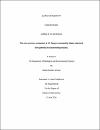The most common mosquitoes at Al- Rayyan municipality (Qatar state) and their potential for transmitting malaria
Abstract
During the period from December 2014 to April 2015, a mosquito survey (Diptera: Culicidae) was conducted at Al Rayyan Municipality, western region of Qatar. The survey aimed to identify the most common mosquitoes species in the study area and assess their potential in transmitting malaria. In all, 37 collection sites were visited throughout the study period revealing 312 mosquitoes. Larvae were collected as well as adults. The pH of larvae breeding sites was also measured in the laboratory. Also, Several maps have been produced using GIS, showing sampling locations. Species identification was carried out using the available standard keys. The survey revealed the presence of four mosquito species representing three genera: Culex 91% (3 species), Anopheles 6% (1 species) and Coquillettidia 3%. The species encountered were: Culex vagans (Wiedemann 1828), Culex mimeticus (Noe 1899), Culex bitaeniorhynchus (Giles 1901) and Anopheles stephensi (Liston 1901). Results showed that the most abundant mosquitoes were Culex, although there was no previous record of the new encountered species. Encountered breeding sites were sewage waste water bonds, construction water tanks, animals drinking containers and abundant small containers. Malaria in Qatar is not endemic, however, it is one of the utmost frequently introduced communicable diseases. The presence of malaria vector borne diseases (Anopheles stephensi), availability of breeding sites, and the presence of individuals who are infected with malaria protozoans (Plasmodium spp.), states the risk of a reintroduction of malaria to Qatar.
DOI/handle
http://hdl.handle.net/10576/3906Collections
- Biological & Environmental Sciences [102 items ]


